View Content #26664
| Contentid | 26664 |
|---|---|
| Content Type | 4 |
| Title | A Scavenger Hunt Activity Using Google Translate |
| Body | By Leila Tamini Lichaei, CASLS Fellow Lesson objectives: Learners will be able to
Level: Novice High - Intermediate Low There are many ways to use instant translation apps in the classroom, such as:
There are newer features to the instant translation apps such as:
In this activity we are going to see how a scavenger hunt game can be done with the help of Google Translate’s picture translation feature. Before doing the activity, have your language learners download Google Translate’s app. You could use any other similar app that you are familiar with. Pre-activity Activity Then explain to learners that you are going to play a scavenger hunt game in which learners are going to walk around the classroom, use their Google Translate app to read the pictures and complete the worksheet. In the worksheet, there are a list of clues that would help learners identify the signs. They should also write down the machine translations. Then explain to learners how this app works and what the features are. Also model translating one sign as an example for them. Here is how it looks when you use the app to translate a sign:
Post-Activity Lastly, ask learners to work in pairs or groups, compare their own translations with the machine translation, and answer the following questions:
In the end, go over all the signs, explain the correct meaning of each sign, and discuss the errors and the limitations of the program.
|
| Source | CASLS Activity of the Week |
| Inputdate | 2019-03-15 22:54:50 |
| Lastmodifieddate | 2019-03-18 04:42:43 |
| Expdate | Not set |
| Publishdate | 2019-03-18 02:15:01 |
| Displaydate | 2019-03-18 00:00:00 |
| Active | 1 |
| Emailed | 1 |
| Isarchived | 0 |


